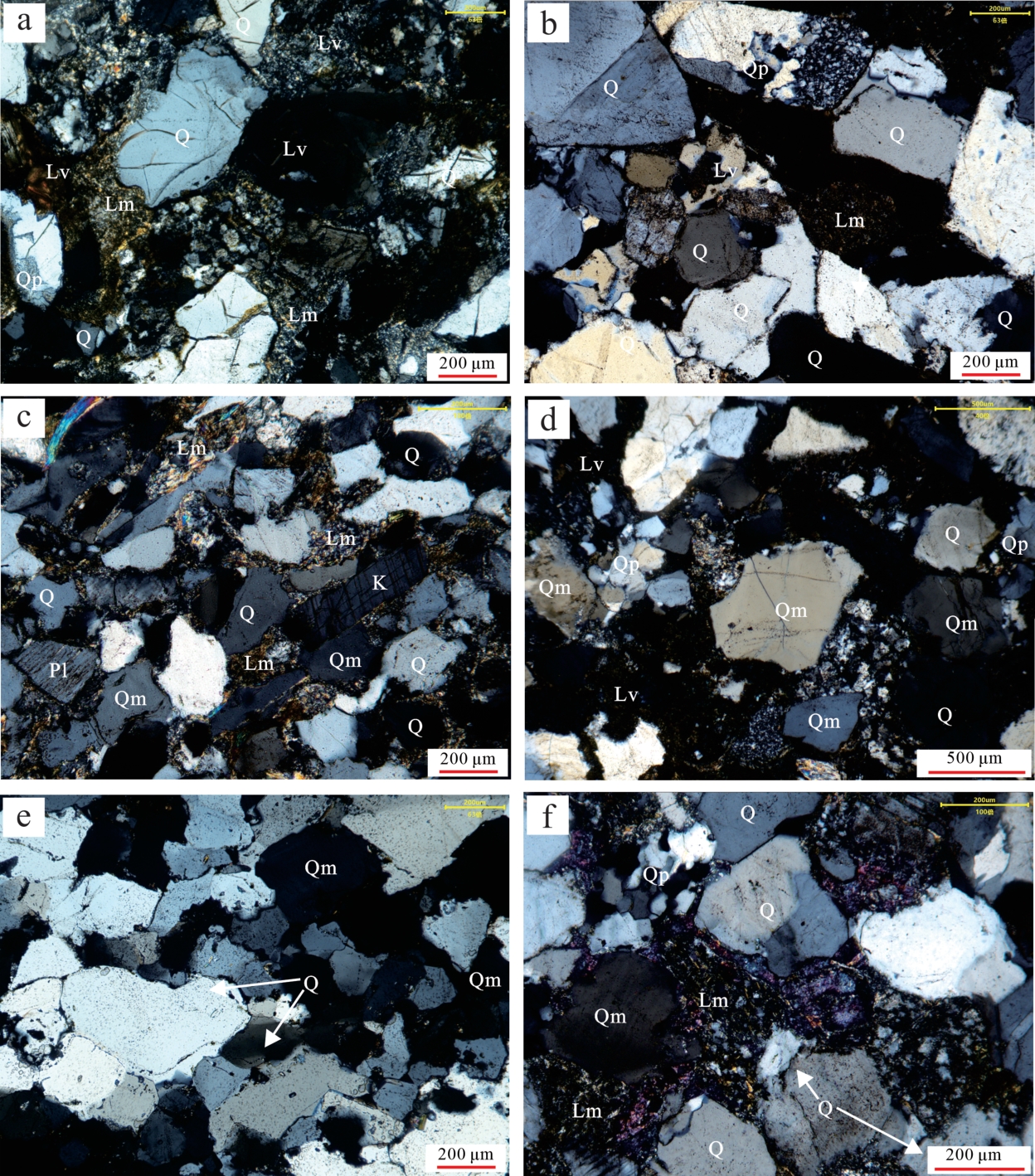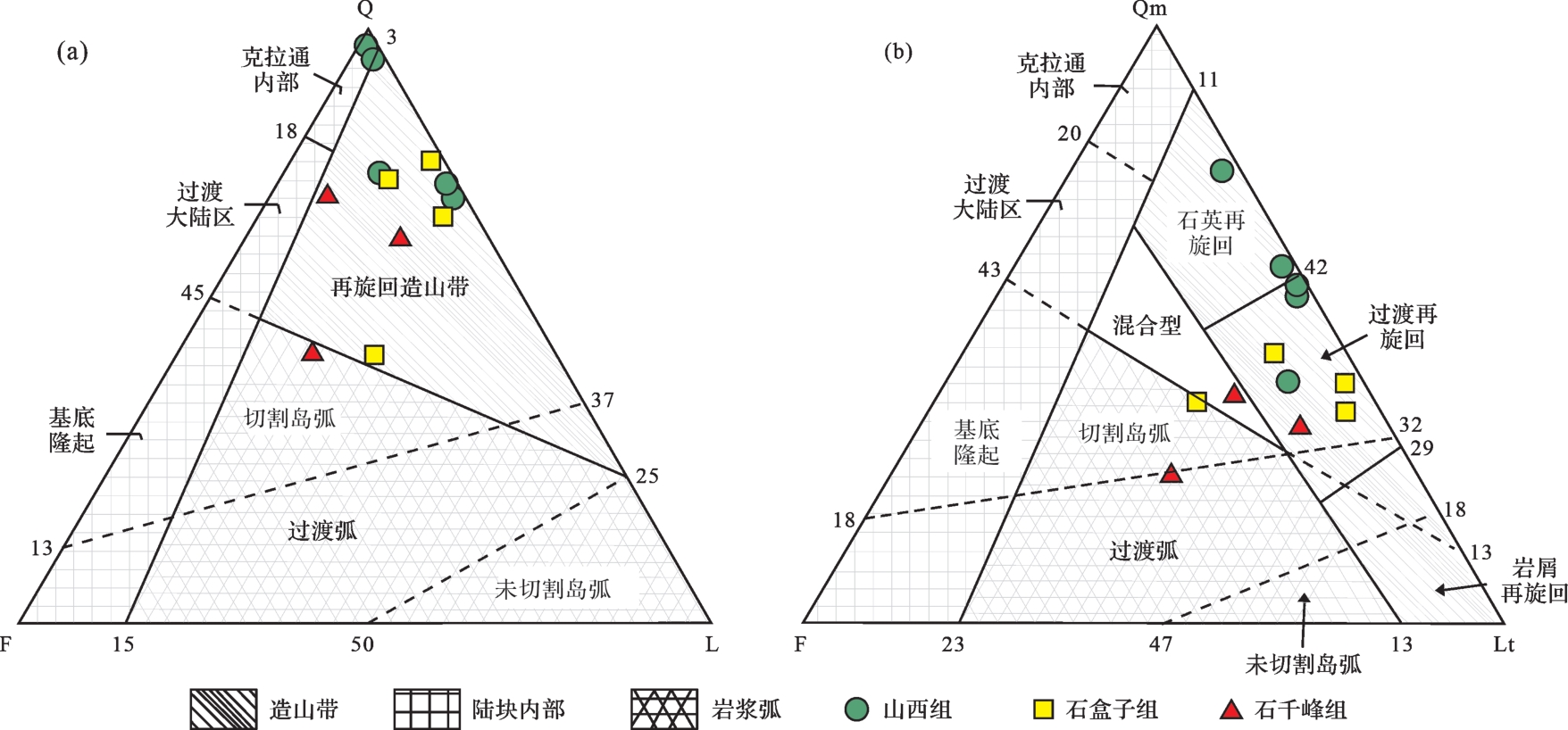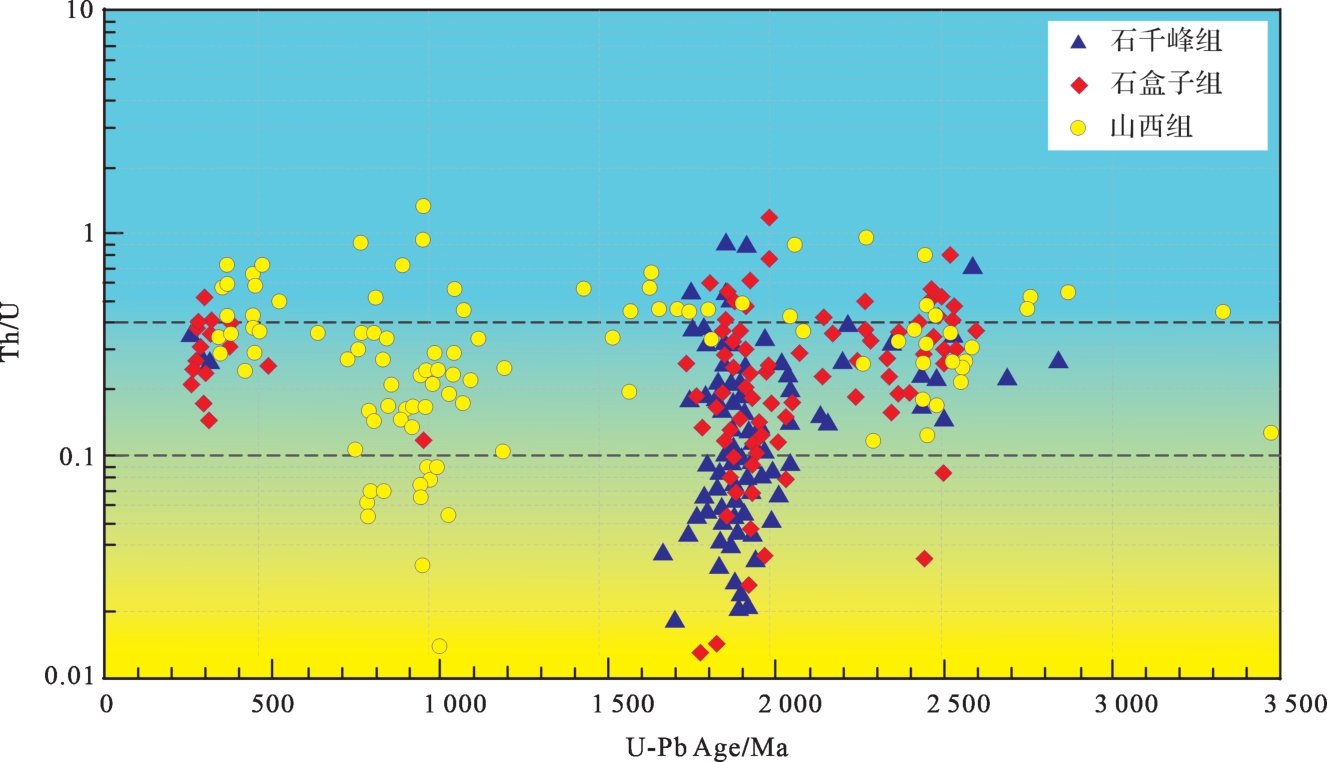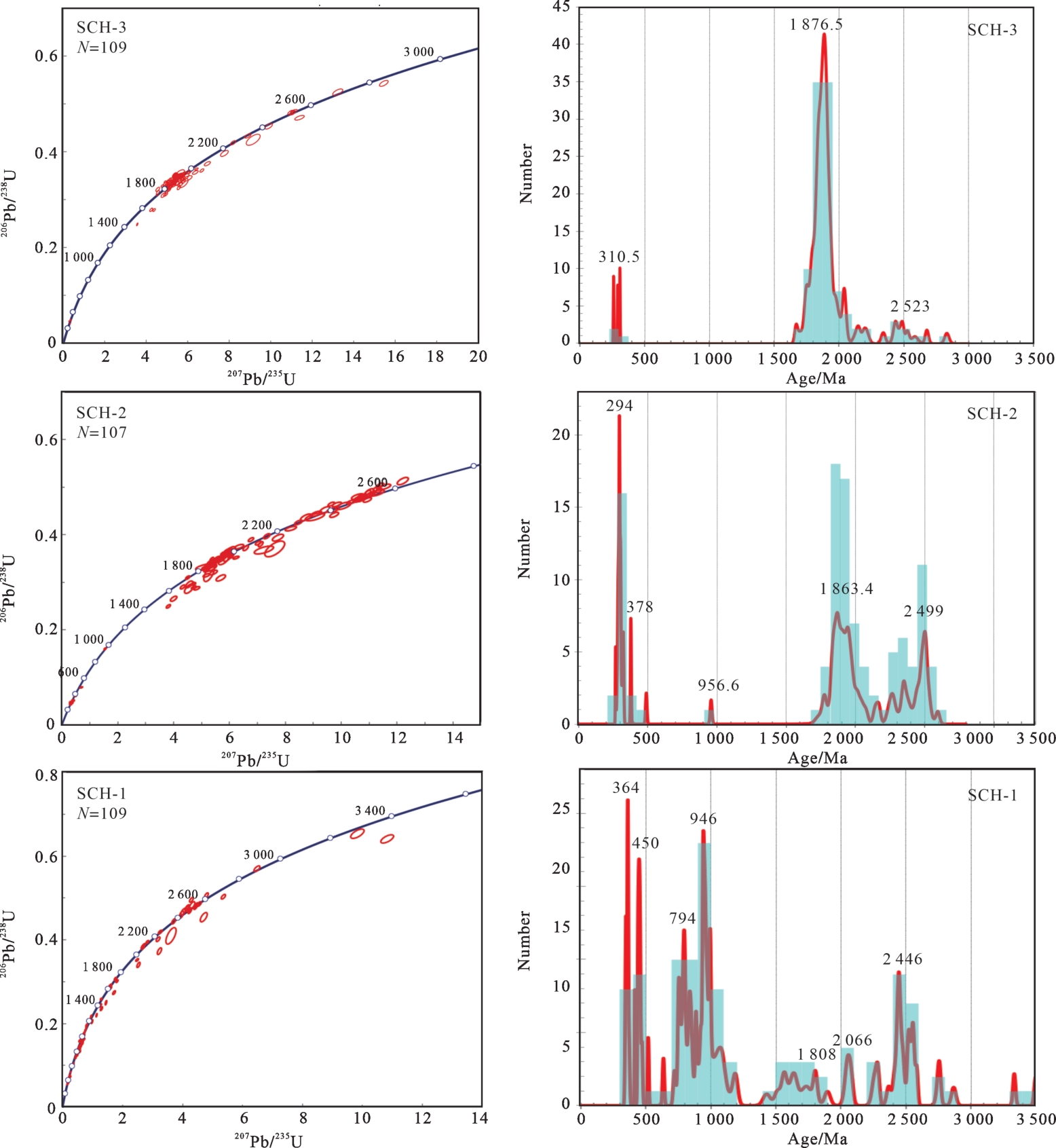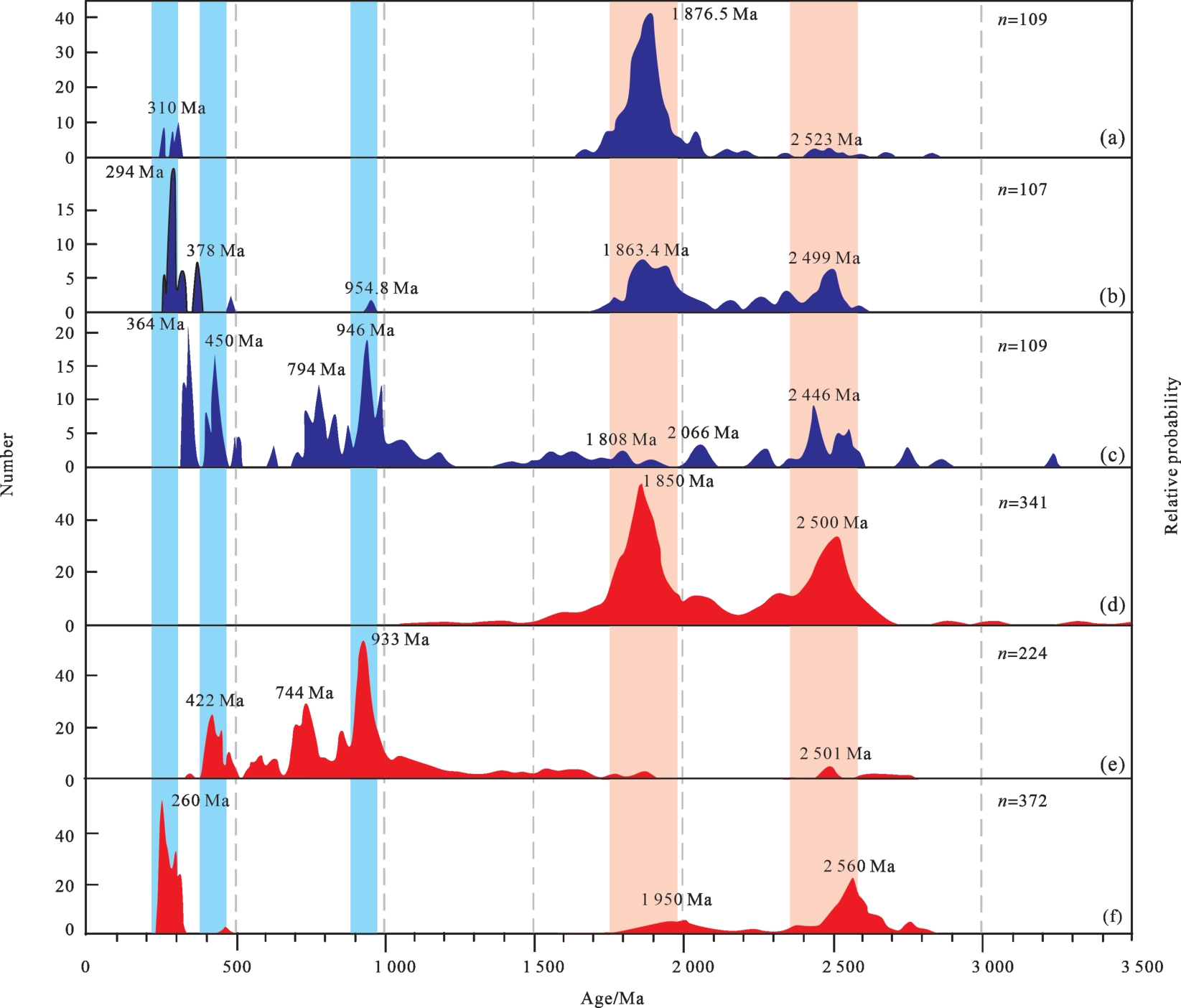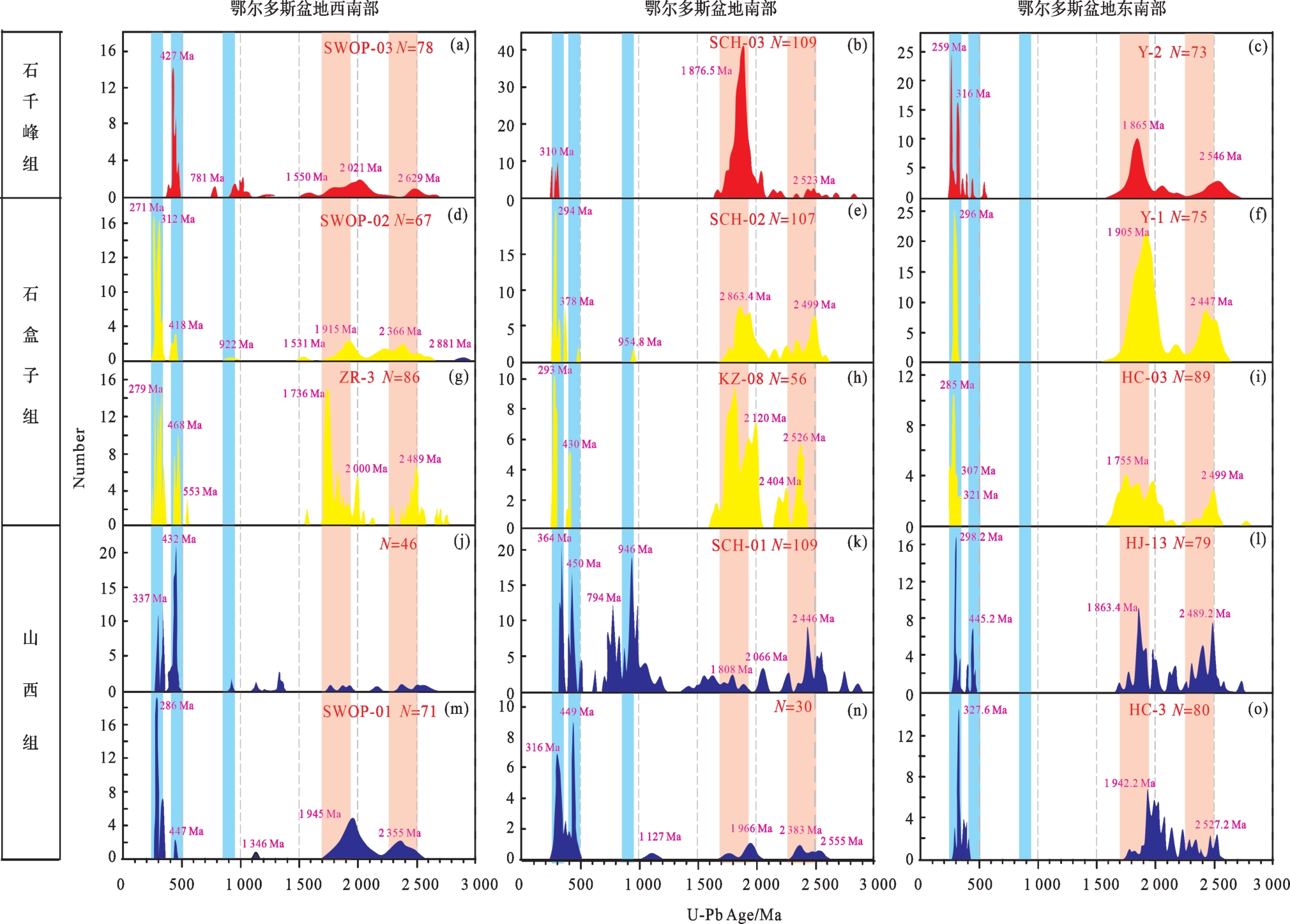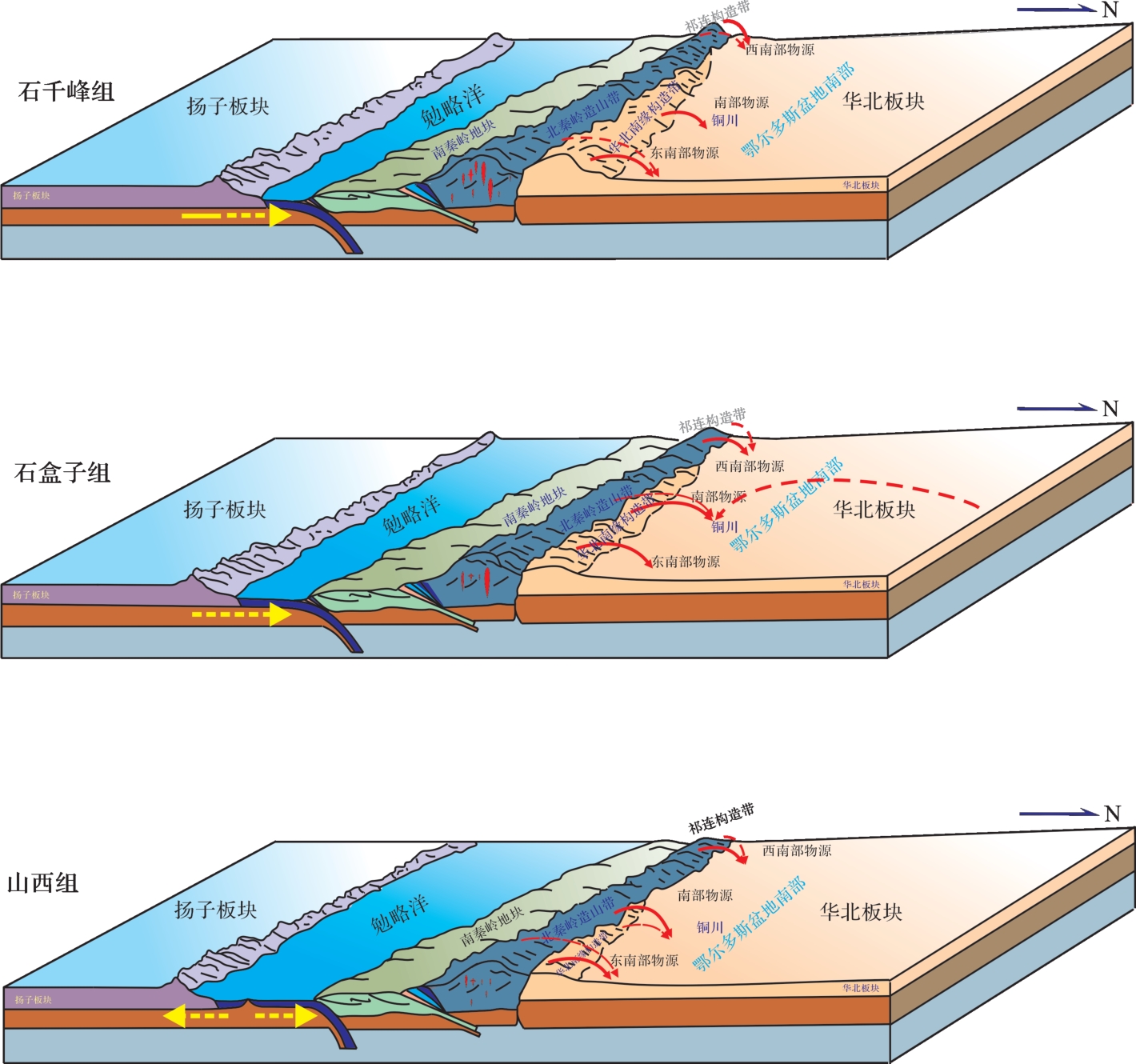HTML
-
在盆—山系统中,造山带的形成和演变控制着沉积盆地的成因和物质组成,沉积盆地中的碎屑沉积物又记录了造山带和沉积盆地之间相互作用的过程[1⁃2],盆山耦合关系是大陆动力学研究的一个重要途径[3⁃5]。位于鄂尔多斯盆地南部的铜川地区在构造上属于渭北隆起,其南部紧邻秦岭造山带(图1)。其中,石川河剖面二叠系地层出露完整连续,沉积地层不仅记录了鄂尔多斯盆地上古生界二叠系的沉积充填演化和物源变化,同时也蕴含着秦岭造山带闭合—碰撞造山过程的构造信息。

Figure 1. (a) Outline of the Ordos Basin and its periphery and the tectonic position of the study area (modified from reference [6]); (b) the southern section of the Ordos Basin; (c) geological cross⁃section of the Permian strata in the Shichuanhe
对于鄂尔多斯盆地南部上古生界的物源分析及构造背景,前人主要运用了岩石学、轻矿物分析、重矿物分析、古流向分析、沉积地球化学常量、微量及稀土元素等方面进行过研究[7⁃12],也有学者通过盆地南部的钻井岩心样品的碎屑锆石测年分析,明确了盆地局部区域内的母岩信息和年代学特征[2,13⁃19]。但由于华北板块晚古生代受南北两侧造山带共同作用的影响,鄂尔多斯盆地构造格局和沉积体系一直存在较大争议[2,8,12,20⁃23]。近年来,已有学者从盆地沉积物及物源分析角度开展盆地与周缘造山带的构造演化研究,但主要集中在华北板块北部和中部地区[19,23⁃24],华北板块南部的研究中大多仅对二叠纪部分时段的物源—构造开展分析[2,25⁃26],或是在鄂尔多斯盆地西南部[17]、华北板块东段宜阳地区开展了盆山演化研究[27],而对鄂尔多斯盆地南缘从早二叠世山西期到晚二叠世石千峰期物源体系变化的系统研究相对薄弱,致使对整个鄂尔多斯盆地南缘与秦岭造山带的盆山耦合关系的认识相对模糊。
碎屑锆石U-Pb测年是物源分析和区域构造演化研究中有效的技术方法[6,28]。因此,本文选取鄂尔多斯盆地南缘铜川地区石川河剖面晚古生代二叠系山西组、下石盒子组和石千峰组的3个砂岩样品进行碎屑锆石U-Pb测年,结合TIMA定量矿物分析,以及古水流数据对盆地南部物源区进行判断,明确华北板块南部晚古生代二叠系构造及沉积充填演化过程,探讨秦岭造山带和华北南缘构造带与鄂尔多斯盆地南部物源变化的耦合关系。
-
秦岭造山带夹持于华北板块与扬子板块之间[29](图1),自元古代到中生代早期经历了多次碰撞、俯冲和增生,最终在三叠纪中晚期形成了复合型大陆造山带[30⁃33]。秦岭造山带在区域上可划分为四大构造单元,分别为华北克拉通南缘、北秦岭、南秦岭和扬子陆块北缘,洛南—栾川断裂带、商丹缝合带和勉略缝合带是它们的分界线[22,31,33]。秦岭造山带和周缘造山带的构造活动控制着华北板块的沉积演化。中奥陶世末,秦岭—祁连造山带和中亚造山带相向俯冲,使华北板块大面积隆升并遭受剥蚀,直至石炭系由于区域拉张,才开始接受沉积[34],此时盆地被中央古隆起分隔,划为祁连海和华北海两部分。早二叠世,华北板块在与西伯利亚板块和秦岭大别板块的碰撞过程中,两侧隆起的不同步运动造成了板块内部的“翘板式”构造运动[19,23⁃24]。至晚二叠世,由于南北两侧持续挤压隆升,使盆地内海水逐渐退出,华北板块成为陆相沉积区。
华北南缘构造带位于三门峡—鲁山—舞阳断裂与洛南—栾川断裂之间。原属于华北板块,只是后期被卷入造山带[29]。华北板块南缘具有与华北克拉通相同的基底,主要为太古宙—古元古代的多套变质结晶基底[27,35⁃36],中元古代—古生代以熊耳群、栾川群等火山岩群为主[29]。鄂尔多斯盆地南部铜川地区,地层完整连续,上古生界碎屑岩角度不整合在奥陶系马家沟组灰岩之上。观测剖面位于陕西铜川市耀州区西北侧的石川河,该剖面二叠系地层出露良好。本次研究分别在山西组、下石盒子组和石千峰组分别采集了3个样品(图2)。

Figure 2. Typical lithologic photos, schematic diagram of stratigraphic⁃lithologic and sampling position map of the Permian Shichuanhe section in the Tongchuan area
山西组的底部发育一套厚层灰色中细粒砂岩,向上为黑色泥岩与深灰色泥质粉砂岩或浅灰绿色砂岩的互层(图2f),向上泥质含量逐渐增加。泥岩页理发育,植物化石常见,多见碳屑、植物茎秆或植物叶片化石。采样位置位于山西组底部,坐标为34°98′4.7″ N, 108°88′7.60″ E。
下石盒子组总体以砂岩为主,底部发育含细砾砂岩层(图2c),成分主要为石英和燧石等;下部主要为棕红色含砾中粗砂岩夹灰色粉砂岩,发育板状交错层理;上部为灰色中细砂岩夹灰绿色或紫红色泥岩。采样位置位于剖面中下部,坐标为34°98′5.7″ N,108°88′5.3″ E。上石盒子组由中厚层含砾中粗砂岩、黄绿色粉砂岩(图2d)及紫红色泥岩组成。
石千峰组底部为一套灰色厚层状含砾粗砂岩(图3a),向上为棕红色—紫红色的含砾砂岩与泥岩的不等厚互层。砂岩中板状交错层理发育。采样位置位于剖面中下部,坐标为34°98′8.30″ N,108°587′6.8″ E。
-
通过尼康LV100显微镜以及DF-F11-U2照相系统对12块砂岩样品进行薄片鉴定和显微照相。在显微镜下采用计点数法统计出不同碎屑颗粒的类型和数量,换算为Dickinson三角图解(1983)3个端元的质量分数,并在Dickinson三角图解上投点,获取物源区的构造背景信息。使用西澳大利亚科廷大学约翰·德莱特中心(JdLC)的TESCAN集成矿物分析仪(TIMA)平台对已经制备的岩石薄片(28×48 mm的探针薄片)进行了自动定量矿物学分析[37⁃39],从而获得碎屑组分矿物含量的定量信息。样本使用点映射采集模式以3.0 μm像素分辨率分析,原始数据使用TIMA软件v1.5.47进行处理。TIMA将高分辨率场发射扫描电子显微镜与四个硅漂移能量色散光谱检测器集成在一起,允许对矿物组合、浓度和晶粒尺寸以及多个晶粒样品上的元素分布进行超快测量,薄截面或抛光截面[37]。
-
在河北省廊坊市河北新航测绘院岩矿实验测试中心通过常规重液体和磁性技术从砂岩样品中分离出锆石。每个砂岩样品分选出的锆石颗粒一般均不少于1 000粒,在双筒目镜下随机精选锆石约200粒整齐排列后,用环氧树脂灌注,通过电加热,固化后打磨并在抛光机上抛光。所有锆石在JEOL JXA-8100电子微探针上获得了背向散射电子(BSE)和阴极发光(CL)图像,用于显示锆石颗粒内部结构。根据颗粒的内部形态选择目标点,以避开夹杂物、裂缝和变质结构等区域。
砂岩碎屑锆石样品均采用LA-ICPMS U-Pb定年分析,测试在中国科学院西北生态环境资源研究院油气资源研究中心完成。锆石U-Pb测年采用Agilient公司的7500a ICP-MS与MicroLas公司的GeoLas200M联机测定。测试中利用氦气作为激光剥蚀物质的载体,剥蚀斑束直径为32 μm,频率为10 Hz,能量为90mJ。采用人工合成硅酸盐玻璃标准参考物质NIST610和哈佛大学91500标准锆石进行仪器最佳化和外部校正。采样方式为单点剥蚀。每一分析点气体背景采集时间为30 s,信号采集时间为40 s。元素浓度计算以NIST610为外标,Si为内标。
-
通过对石川河剖面砂岩波痕、交错层理前积层、叠瓦状砾石倾斜面等测量古流方向,结合沉积地层的产状,基于吴氏网原理,采用极射赤平投影软件Stereonet对地层倾角大于10°的古流向数据进行恢复校正,去除构造对产状的影响。再通过利用PC99软件作古流向玫瑰图恢复研究区的古流向。
2.1. 岩石薄片鉴定及定量矿物学分析
2.2. 锆石U⁃Pb同位素测年分析
2.3. 古水流分析
-
岩石学特征分析表明,铜川石川河二叠系山西组砂岩主要为岩屑石英砂岩及石英砂岩(图3e,f);细—中粒结构,分选—磨圆中等;颗粒支撑,孔隙式—接触式胶结,颗粒间多被硅质及泥铁质充填;碎屑组分主要为石英及岩屑,石英含量介于40%~70%,平均为51%,普遍具自生加大边,其中单晶石英占绝大多数;岩屑含量介于6.4%~24.6%,平均为18.4%,以石英岩、千枚岩等变质岩岩屑为主,其次为少量隐晶岩及喷出岩岩屑,沉积岩屑极少;长石含量普遍较低,平均1.9%,蚀变明显。
石盒子组砂岩主要为岩屑砂岩及长石岩屑砂岩(图4c,d);中—粗粒结构,分选中等—较差;颗粒支撑,接触式胶结,粒间多为蚀变凝灰质及泥质填隙物充填;碎屑组分仍以石英及岩屑为主,其中,石英含量介于31%~45%,平均为36.7%,石英颗粒普遍具破裂纹,部分石英具港湾状溶蚀边,多晶石英含量增加;岩屑含量介于17%~28%,平均为21.4%,主要为石英岩、高变岩、千枚岩、板岩等变质岩岩屑以及喷出岩、隐晶岩等火成岩岩屑;长石含量较山西组明显增加,平均含量8.7%,以蚀变斜长石为主。

Figure 4. Permian TIMA (Tescan integrated mineral analyzer ) mineral image and energy spectrum of minerals from the Permian sandstone in the Shichuanhe section, Tongchuan
石千峰组砂岩主要为岩屑长石砂岩及长石岩屑砂岩(图4a,b);中—粗粒结构,分选中等—较差,颗粒支撑,孔隙式—接触式胶结,粒间多被绢云母、钙质及泥铁质充填;碎屑组分中石英含量介于29.8%~70%,平均为50%,平均为40.1%;岩屑含量介于16.4%~28.8%,平均为22.9%,主要为石英岩、高变岩等变质岩岩屑以及隐晶体岩、喷出岩及花岗岩等火成岩岩屑;长石含量较山西组、石盒子组含量有明显升高,平均含量可达18.4%,以斜长石为主。
从铜川石川河二叠系剖面中挑选出3个样品进行TIMA定量矿物学分析(图4)。山西组样品(SCH-1)石英含量为97.62%,其次为白云母1.87%,长石含量极低(图4c)。石盒子组样品(SCH-2)石英含量为91.27%,其次为钠长石2.43%、方解石2.33%、赤铁矿/磁铁矿1.98%、钙长石0.77%、白云母0.43%、黑电气石0.42%、硅灰石0.23%(图4b)。石千峰组样品(SCH-3)石英含量为75.46%,其次为钠长石14.88%、高岭石5.01%、白云母3.33%、赤铁矿/磁铁矿1.04%、黑电气石0.09%(图4a)。从山西组到石千峰组,砂岩矿物组分中石英含量逐渐降低,长石含量逐渐升高,说明二叠系沉积时,混入的岩浆岩物源逐渐增多。
砂岩碎屑组分在一定程度上能够反映造山带剥露与盆地沉积充填过程的耦合关系。根据研究区12件砂岩薄片的碎屑组分统计及3件TIMA定量矿物分析结果,采用Dickinson分析理论在Q-F-L、Qm-F-Lt三角图解上投点[40]。Q-F-L三角图解图5a显示,山西组的砂岩碎屑组分主要落在图解上的克拉通内部及再旋回造山带区域,石盒子组的砂岩碎屑组分主要投在再旋回造山带区域,石千峰组的砂岩碎屑组分主要投在再旋回造山带及切割岛弧区域。Qm-F-Lt三角图解(图5b)进一步显示:山西组物源区为再旋回造山带的石英再旋回和过渡再旋回区,石盒子组物源区主要为过渡再旋回区,石千峰组物源区为混合型、过渡再旋回及过渡弧区。

Figure 5. Dickinson's detrital triangular charts of the Permian sandstone in the Shichuanhe section, Tongchuan (QFL plot from Dickinson et al.[40])
-
在样品的锆石阴极发光(CL)图像上可见,山西组锆石颗粒大小主要介于70~100 μm,石盒子组主要介于50~80 μm,石千峰组锆石颗粒大小主要介于80~150 μm。各样品中锆石颗粒多具震荡环带或扇形结构,自形程度较好,代表岩浆成因[41]。少量锆石显示为核、边分明的结构,可能是后期的岩浆锆石包裹原核部锆石的继承或捕获锆石,或后期重结晶的变质锆石[42](图6)。

Figure 6. Cathode luminescence images of typical zircon particles in three Permian samples from the Shichuanhe section, Tongchuan
锆石年龄蕴含了成岩或结晶的时间信息,利用锆石的Th/U比值还能分析锆石的来源[41⁃44]。研究区二叠系锆石中Th/U>0.4的颗粒占19%,反映了岩浆锆石成因。Th/U介于0.1~0.4的颗粒占57%,反映岩浆锆石颗粒受到较强的变质作用影响。其余24%的锆石Th/U<0.1,反映了变质锆石成因。在年龄段为1 800~2 000 Ma的锆石中,45%的颗粒Th/U<0.1,代表该时期变质成因的锆石较多(图7)。
-
根据锆石颗粒的CL图像标定目标,避免夹杂物和破裂。由于低放射性铅浓度和铅校正相关的不确定性,小于1 000 Ma的年龄根据更可靠的206Pb/238U比率计算,而较老的年龄根据207Pb/206Pb比率计算[45]。研究中只有谐和度为90%~110%的锆石才被认为适用于年龄统计计算。研究总共获得了325个谐和年龄数据,年龄分布特征如图8。

Figure 8. Concordia diagrams and relative probability plots showing detrital zircon U⁃Pb ages of the Permian sandstone in the Shichuanhe section, Tongchuan
山西组样品(SCH-1)123颗锆石中109颗符合谐和度要求,锆石年龄介于345.8~3 498 Ma,呈现364 Ma、450 Ma、794 Ma、946 Ma和2 446 Ma 5个主峰值年龄段和1 808 Ma和2 066 Ma两个次峰值年龄段。石盒子组样品(SCH-2)121个锆石中107颗符合谐和度要求,年龄介于267.1~2 595 Ma,锆石年龄呈现267.1~304.4 Ma(15粒)、314~488.5 Ma(6粒)、956.6 Ma(1粒)、1 735~2 078 Ma(51粒)、2 143~2 595 Ma(34粒)5个峰值年龄段,其中294 Ma、1 863.4 Ma和2 499 Ma为主要峰值年龄。石千峰组样品(SCH-3)111颗锆石中109颗符合谐和度要求,年龄介于262.2~2 832 Ma,呈现262.2~310.9 Ma(3粒)、1 669~2 045 Ma(93粒)、2 130~2 832 Ma(13粒)3个峰值年龄段。
-
在铜川石川河二叠系剖面山西组—石千峰组露头中采集了56个测量值,古水流玫瑰花图呈多峰分布模式(图2),表明相对可变的古水流方向。但是大多数数据从300°~45°,指示古水流方向总体向北,表明研究区二叠系物源方向主要为自南向北。
3.1. 砂岩碎屑组分特征
3.2. 锆石的形态和成因
3.3. 碎屑锆石的U⁃Pb年龄
3.4. 古水流方向
-
研究中来自铜川地区二叠系的3个碎屑锆石样品主要包含4个年龄组:新太古代—古元古代(1 690~2 830 Ma)、新元古代(794~956 Ma)、早古生代(450~488 Ma)和晚古生代(262~364 Ma)(图9)。

Figure 9. Comparison of detrital zircon age frequency between the Shichuanhe section and potential provenance in the Tongchuan area
新太古宙和古元古代构造岩浆事件的记录广泛分布于整个华北克拉通,代表了华北克拉通前寒武纪结晶基底的年龄[47⁃51](图9d)。华北克拉通的形成先后经历了早期陆壳形成(>3 000 Ma)[52]、主要陆壳生长事件(2 900~2 700 Ma)[53]、克拉通统一基底的形成(~2 500 Ma)[53⁃56]、古元古代造山事件(2 300~1 900 Ma)[57]以及东部陆块和西部陆块碰撞拼合事件(~1 850 Ma)[55,58⁃59]。太古宙TTG花岗质岩石(Tonalite-TrondhjemtiteGranodiorite,英云闪长岩—奥长花岗岩—花岗闪长岩)在整个华北克拉通的形成时代3 800~2 500 Ma几乎连续分布[46]。
新元古代锆石广泛存在于秦岭构造带中,代表了与Rodinia超大陆聚合背景下的格伦维尔造山运动有关的同碰撞到后碰撞的花岗岩浆演化活动[33,58⁃59]。其锆石年龄主要分为1 000~900 Ma和850~700 Ma两个阶段(图9e)。其中,1 000~900 Ma的锆石在北秦岭造山带秦岭群中常见[60];850~700 Ma的新元古代锆石年龄与南秦岭和扬子北缘的晋宁期岩浆活动密切相关,可能代表了Rodinia超大陆裂解过程中发生的岩浆活动[61]。
早古生代420~500 Ma的锆石广泛地分布于北秦岭造山带[62⁃63](图9e),记录了北秦岭造山带加里东期的岩浆活动。该时期又可分为早期板块俯冲(505~470 Ma)、中期块体的聚合碰撞、挤出(450~422 Ma)和晚期全面聚合碰撞(415~400 Ma)三个造山阶段[64]。
晚古生代锆石在华北板块晚古生代—早中三叠世地层中广泛存在[63,65⁃66]。北部,由于兴蒙造山带和内蒙古隆起地区晚古生代强烈岩浆作用[67⁃69],晚古生代地层中广泛存在260~350 Ma年龄组的碎屑锆石[26,63,65](图9f)。南部,北秦岭造山带在260~350 Ma期间也存在显著构造热事件[26,70⁃71],如侵入秦岭群变质地层中的翠华山岩体(345 Ma)、宝鸡岩体(262 Ma)和侵入于宽坪群中的蟒岭岩体(291 Ma),以及丹凤群中的少量线型小岩体[72]。据前人研究北秦岭柳叶河盆地石炭系—二叠系砂岩中含有的250~360 Ma锆石也可能来自北秦岭该时期的岩浆岩[73]。
根据以上分析,研究推测铜川地区二叠系的碎屑物质可能来自北秦岭造山带、华北南缘构造带或华北板块北缘3个主要潜在物源区。
-
1) 山西组(SCH-1)物源
样品SCH-1中,碎屑锆石具有364 Ma、450 Ma、794 Ma、946 Ma、1 808 Ma、2 066 Ma和2 446 Ma等多个峰值年龄(图9)。其中,新太古代和古元古代(1 808 Ma、2 066 Ma、2 446 Ma)锆石推测来自华北克拉通前寒武纪基底岩石。新元古代的794 Ma和946 Ma峰值年龄与北秦岭造山带宽坪群的年龄有很好的对应[74]。早古生代锆石(450 Ma)来自于北秦岭造山带,据锆石颗粒的CL图像显示该时期的锆石颗粒主要为岩浆成因[75],与北秦岭造山带在该时期岩浆活动频繁相一致。再结合古流向自南向北的分析结果,推测该时期晚古生代锆石(364 Ma)来自现今被逆冲带掩盖的勉略构造带岩浆活动的剥蚀产物[76]。综上,认为研究区山西组的主要物源区是北秦岭造山带,次要物源区是华北板块南缘构造带。
2) 石盒子组(SCH-2)物源
样品SCH-2中,碎屑锆石具有294 Ma、378 Ma、954.8 Ma、1 863.4 Ma和2 499 Ma等5个峰值年龄(图9)。其中,新太古代—古元古代(2 499 Ma、1 863.4 Ma)的碎屑锆石主要来自华北克拉通结晶基底。新元古代的锆石(954.8 Ma)含量极少,该样品中仅含1颗,推测主要来自北秦岭造山带。晚古生代锆石(378 Ma、294 Ma)所占比例最大,从样品SCH-2年龄频谱图上可见,年龄峰值最大的294 Ma与北秦岭锆石年龄谱图不符合,与内蒙古隆起西段的锆石年龄谱图相似度更高(图9)。从碎屑组分特征来看,石盒子组砂岩与山西组和石千峰组相比,具有更高含量的方解石、黑电气石、硅灰石、铁阳起石,判断应有不同物源的物质加入,其中电气石在盆地北部物源体系中常见[8]。此外,虽然研究区石盒子组古水流方向主要为自南向北,但在研究区西南方约40 km的泾阳口镇一带的下石盒子组测得古水流方向,明显有自南向北和自北向南两个主要方向[8]。因此,推测该时期研究区处于南北混源区,北秦岭造山带、华北板块南缘、内蒙古隆起西段共同提供物源。
3) 石千峰组(SCH-3)物源
样品SCH-3中,碎屑锆石具有310.5 Ma、1 876.5 Ma和2 523 Ma 3个峰值年龄,其中年龄频谱图上古元古代锆石(1 876.5 Ma)的数量大于新太古代(2 523 Ma)锆石数量,与华北板块南缘的锆石年龄谱图相似。缺少北秦岭特征的新元古代和早古生代锆石,推测北秦岭此时已经不为研究区供源。晚古生代锆石(310 Ma)仅有3颗,结合古流向特征,推测这3颗晚古生代锆石可能为前期沉积在华北南缘构造带上物质的再循环。因此推断研究区石千峰组的物源主要为华北南缘构造带。
-
沉积盆地内碎屑物质的成分变化以及碎屑锆石年龄U-Pb年龄峰值的差异不仅可以反映物源区的变化,同时还可以记录周缘造山带的构造演化信息[77⁃78]。鄂尔多斯盆地南部二叠系不同区域砂岩碎屑锆石样品年龄分布存在显著差异(图10)。

Figure 10. Age distributions of detrital zircons from the Permian strata in the southern Ordos Basin
盆地南部,研究的铜川地区,下二叠统山西组碎屑锆石年龄表现出新元古代—早古生代以及晚古生代锆石含量较高,新太古代—古元古代锆石含量较低的特点;中二叠统石盒子组碎屑锆石表现出新太古代—古元古代锆石明显增加,晚古生代锆石含量较高,早古生代锆石含量降低的特点;石千峰组碎屑锆石表现出古元古代锆石含量进一步增加,晚古生代锆石含量明显降低的特点。从二叠系的早期到晚期,铜川地区锆石年代学显示华北基底1 876.5 Ma和2 523 Ma年龄组的太古代—古元古代锆石含量明显增加,代表北秦岭特征的~950 Ma和422 Ma的新元古代和古生代年龄在逐渐减小,但始终含有晚古生代锆石年龄。与之相邻的淳化口镇剖面[25],锆石年龄分布也具有新太古代—古元古代锆石含量自山西组—石盒子组逐渐增加,早古生代锆石逐渐减少,晚古生代锆石少量增加的特征。由此推测,盆地南缘中部二叠系物源区处于持续的隆升和剥蚀的状态,山西组的物源主要来自北秦岭造山带,少量来自华北地块南缘;石盒子物源主要来自华北南缘构造带和华北北缘内蒙古隆起西段,来自北秦岭造山带物质减少;石千峰组样品中缺少北秦岭造山带的新元古代和早古生代的锆石,物源以华北南缘构造带为主。推测在山西期,华北南缘隆起幅度较低,北秦岭造山带的物质能被顺利搬运至研究区,而到石盒子期由于北秦岭造山带构造活动增强,使华北南缘构造带开始隆升,大大阻碍了来自北秦岭的物质,至石千峰期,华北南缘构造带继续隆升进而完全阻挡了北秦岭造山带的物质进入研究区。其中石盒子期由于华北北缘兴蒙造山带和内蒙古隆起的强烈活动,鄂尔多斯盆地沉积中心南移到研究区附近,碎屑锆石中混入内蒙古隆起西段的晚古生代锆石。同时,铜川地区碎屑组分也显示石英含量较前期降低,但长石含量较前期明显增加,砂岩成熟度呈降低趋势,反映北秦岭和华北地块南缘逐渐增强的造山过程。在Dickinson三角投点图上显示,源区构造背景由山西期的石英再旋回和过渡再旋回造山带至石千峰期的过渡再旋回—过渡弧构造背景。说明山西期的源区为北秦岭再旋回造山带,石千峰期为多源性物源区,该物源区包括再旋回造山带的基底变质岩和花岗岩、沉积盖层以及同期的火山物质,这可能与华北板块的基底及其与北秦岭的弧—陆碰撞过程相关[57,79⁃80]。
盆地西南部,已发表的锆石数据表明[2,17,25],庆探1井山1段碎屑锆石的两个主峰年龄区间为287~339 Ma和385~466 Ma,三个次峰年龄区间为922~1 332 Ma、1 717~2 062 Ma、2 302~2 522 Ma,推测其物源可能来自北、西秦岭—北祁连造山带、兴蒙造山带和华北板块基底。其中北部兴蒙造山带距离远还能供源,也表明山西组南部构造活动弱,尚未发生强烈的隆升[2]。宝鸡龙凤坪剖面上石盒子组碎屑锆石年龄谱主要分布在254~352 Ma、368~551 Ma、1 700~2 000 Ma和2 400~2 600 Ma这四个区间,判断其上石盒子组的大部分物质来自盆地西北部,可能是古亚洲洋逐渐俯冲和闭合导致盆地西北部抬升的结果,少量物质来源于北秦岭造山带西南部,表明北秦岭造山带此时发生了轻微的隆升[25]。平凉二道沟剖面山西组—石盒子组的锆石主要年龄群为300~270 Ma和2 500~1 700 Ma,其物源主要来自鄂尔多斯盆地西南缘弧形构造带;而石千峰组的锆石年龄谱主要为1 000~800 Ma和500~400 Ma年龄,缺乏二叠纪年龄群,其物源被归因于中祁连地块的显著隆升。300~270 Ma代表勉略洋向北俯冲以及大陆弧中强烈的岩浆活动。上石盒子组和石千峰组的沉积速率明显增大,表明该时期源区经历了显著抬升[25]。
盆地东南部,韩城—河津地区,山西组碎屑锆石中,新太古代—古元古代锆石(~2 489.2 Ma、1 942.2 Ma、1 863.4 Ma)含量高,晚古生代锆石(298.2 Ma、327.6 Ma)含量较高,早古生代锆石(445.2 Ma)含量低的分布特征[81]。该特征与东部铜川—淳化地区石盒子组锆石分布特征具有很好的一致性,推测其物质主要来源于华北南缘构造带,少量来自北秦岭造山带。韩城—宜阳地区石盒子组碎屑锆石年龄分布与山西组具有很好的继承性,表现为古元古代—古元古代锆石(~1 755 Ma、1 905 Ma)含量高、晚古生代锆石(~265 Ma、~298 Ma)含量较高,缺乏或者很少出现早古生代锆石的分布特征[25⁃26];该特征与东部铜川地区石千峰组锆石分布特征具有很好的一致性,推测华北南缘构造带在东部已早于中部先发生了隆起。宜阳地区石千峰组(孙家沟组)锆石分布也表现出以新太古代和古元古代锆石为主,晚古生代锆石比例增加,主峰呈现为~259 Ma和~316 Ma[27]。与西部铜川地区相比,同时还存在少量~500 Ma的早古生代锆石颗粒,表明其物源依然主要来源于华北南缘构造带,早古生代锆石颗粒的出现可能是北秦岭造山带进一步隆升、剥蚀的反映[27]。
对比鄂尔多斯盆地西南、南部及东南部二叠纪不同时期的碎屑锆石年龄分布可以发现,不同区域从早二叠世山西期到晚二叠世石千峰期,均表现出南部构造活动逐渐增强的趋势,反映出构造环境由扩张到俯冲的转变。秦岭造山带晚古生代至中生代早期(345~200 Ma)的蛇绿岩、花岗岩也反映了南秦岭勉略洋从海盆的扩张、开放和最终封闭以及碰撞造山作用的板块构造演化过程[82⁃83]。但构造增强的起始时间在东西方向上存在差异,表现出自东向西逐渐增强的特征。其中,东南部韩城—宜阳地区山西组开始南部构造活动已开始增强,南部铜川地区在下石盒子组构造活动开始增强,西南部在上石盒子组明显增强。这种时间上构造活动增强的差异可清楚地反映华北板块和扬子板块在二叠纪—三叠纪自东向西的剪刀式闭合碰撞启动过程,以及由此所导致的盆地南部古地形和物源体系的演变(图11)。
4.1. 潜在物源区年代学特征
4.2. 物源分析
4.3. 构造—沉积演化意义
-
(1) 铜川地区石川河剖面山西组锆石主要年龄峰值为364 Ma、450 Ma、794 Ma、946 Ma和2 446 Ma,物源主要来自北秦岭造山带,少量来自华北克拉通南缘;石盒子组锆石年龄峰值为294 Ma、1 863.4 Ma和2 499 Ma,物源主要来自华北克拉通南缘和内蒙古隆起西段,仅少量物质来源于北秦岭造山带;石千峰组锆石的年龄峰值为1 876.5 Ma,缺乏北秦岭造山带特征的新元古代和早古生代碎屑锆石记录,推测物源主要由华北南缘构造带提供。
(2) 鄂尔多斯盆地早二叠世山西期开始,勉略洋开启了由扩张向俯冲的转换。由于向北挤压应力的增强,使盆地南部物源区发生了规律性的变化。铜川地区石千峰组锆石以华北南缘构造带为主,缺少北秦岭造山带新元古代和早古生代的锆石,暗示秦岭造山带的隆升使华北南缘抬升,进而阻挡了秦岭造山带的物质进入盆地。
(3) 鄂尔多斯盆地南部自东向西先后隆起,这种时间上的差异可以清楚地反映华北板块和扬子板块在二叠纪自东向西的剪刀式闭合碰撞的启动过程,以及由此所导致的古地形和物源体系的演变。

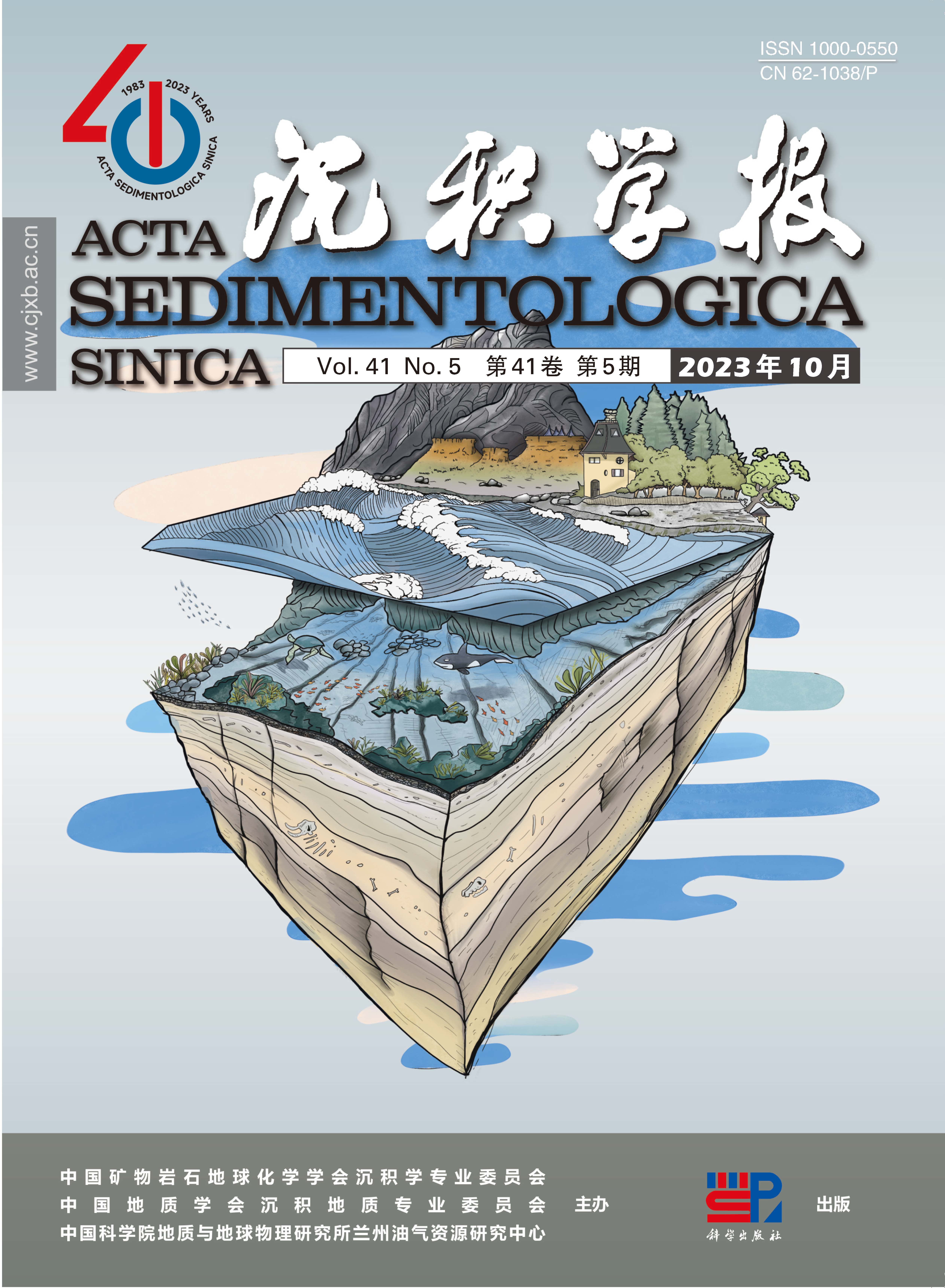


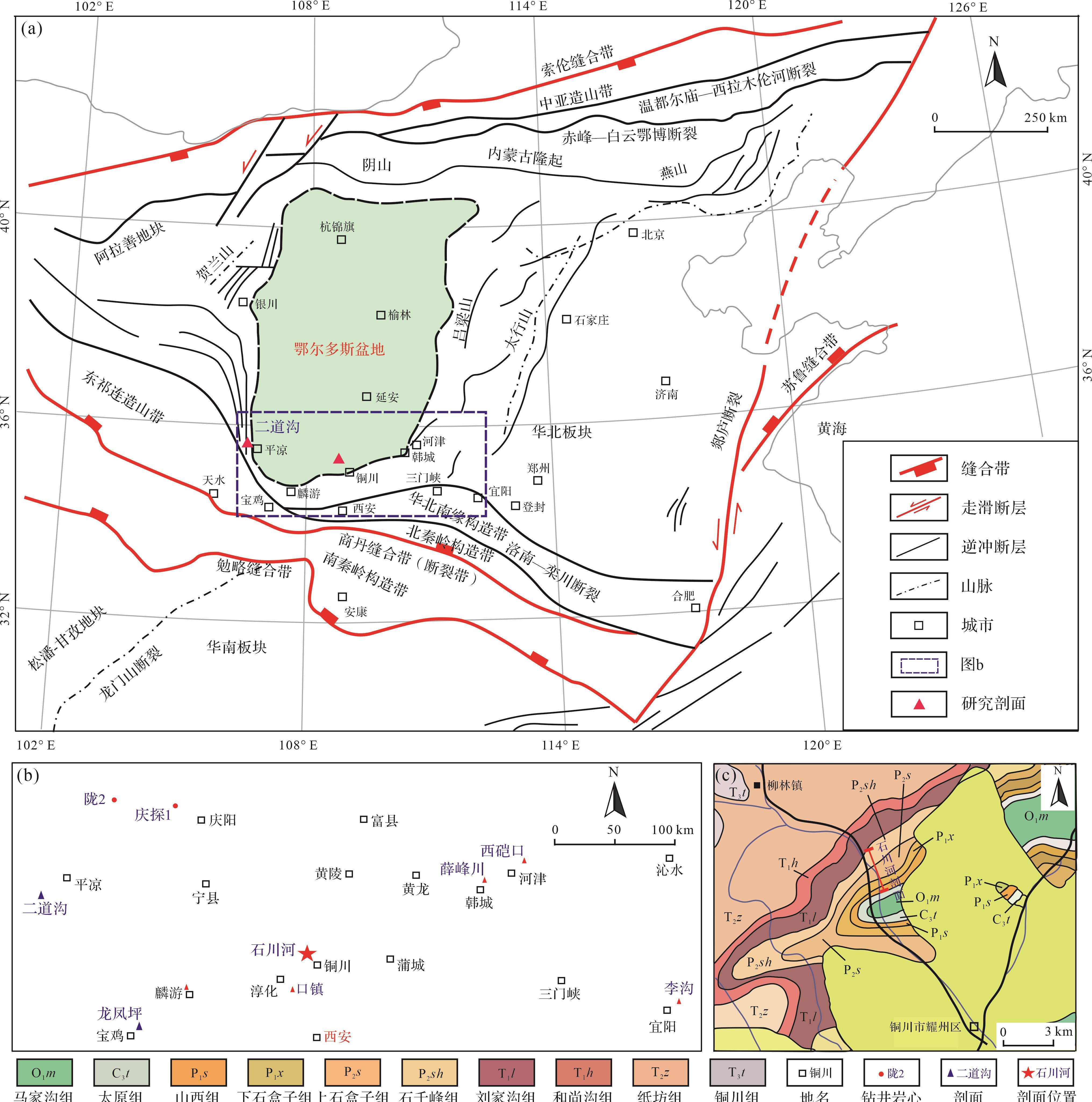





 DownLoad:
DownLoad:

